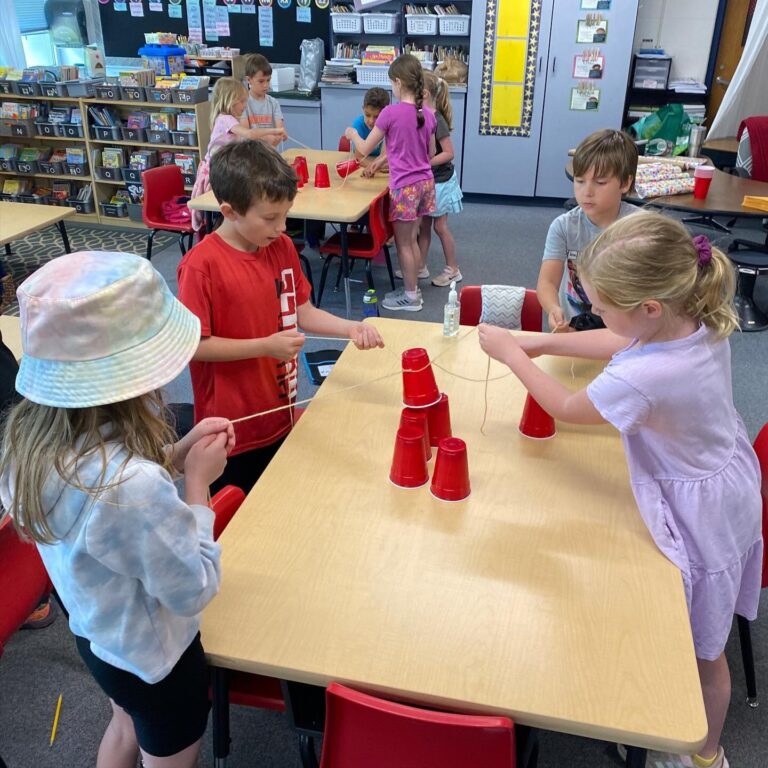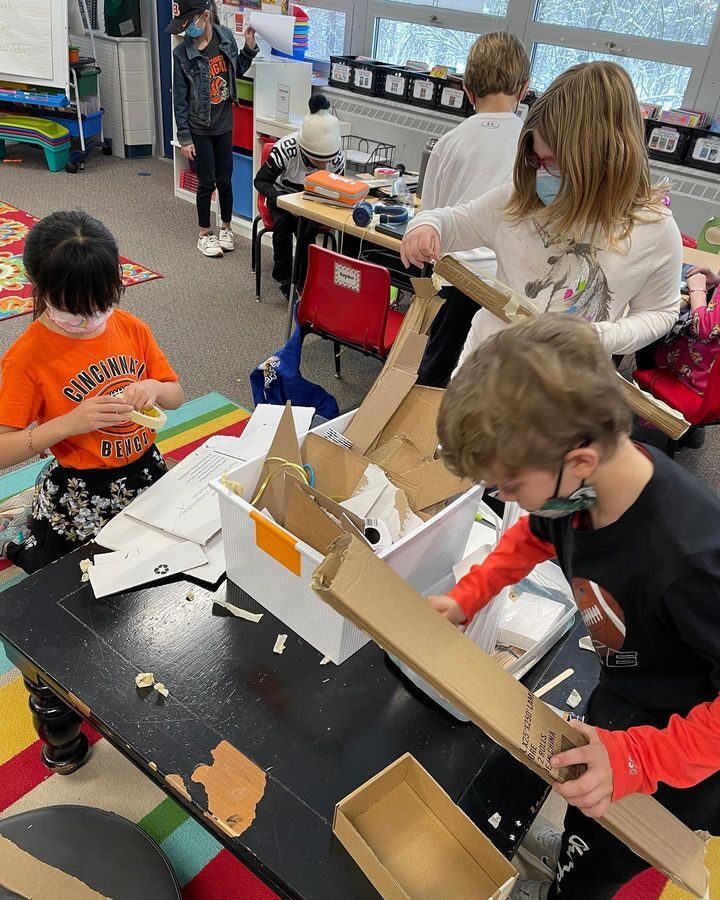In May, the Ohio STEM Committee approved six schools in the state for five years of STEM school designation. Two schools in the Indian Hill Exempted Village School District in the Cincinnati area – Indian Hill Primary and Indian Hill Elementary – received the statewide designation for the first time.
Erin Owens, the principal of Indian Hill Primary School, agreed to answer a few questions about her school and how it sought and achieved the STEM school designation:
Q: Tell us about your school, its students, its mission and the community that it serves.

A: Indian Hill Primary School (IHPS) is a small, suburban school just outside Cincinnati. We serve all K-2 students in the district and have just more than 500 children in those grades.
The community is highly supportive of the schools in all areas. Our community wants and expects the best education for their children, therefore IH Primary aims to do school differently in many ways.
One way we do this is by empowering student voice and choice throughout the curriculum using STEM and Project Based Learning (PBL).
Ensuring that we are a school district that puts student experiences first is what we refer to as the #IHPromise. An integrated STEM curriculum is part of that promise to students and families.
Learn about STEM school designation
Ohio law provides a specific pathway for schools to seek and receive designation as a STEM or STEAM (Science, Technology, Engineering, Art, and Math) school. Designation recognizes a school as an effective place for STEM or STEAM learning.
Q: Why did you seek the statewide STEM School Designation? What was involved in seeking the designation, and, as principal, what did you learn from the process?
A: Seeking STEM designation was the next step in a years-long endeavor to bring the best in STEM education to children across the district. Prior to formally applying, IHPS was engaged in learning and developing a STEM program for more than seven years. We called our work “STEM For All,” and it was born out of the belief that STEM education, design thinking and communication, collaboration, creativity and critical thinking (the 4Cs) are the foundational skills needed to prosper in an ever-changing world.
A team was created that included not only primary school staff but also educators from other buildings, including our board office, to come together and begin the process of cataloging what we already do well and to identify the gaps in our programming in regard to the robust STEM rubric from the Ohio STEM Learning Network (OSLN).
For two years, we met regularly to write about and create artifacts about the student experience related to STEM at IHPS, develop next steps in learning and enhance existing and new partnerships. All along, the staff took part in learning about the rubric in small bites, evaluating their personal practice and learning how to use the design thinking process across all content areas.
The process has allowed us to make long-term plans for growth and feel confident that we are doing great work with and for children, while understanding that we get to continue to learn and improve in the area of STEM education with the help of amazing partners.
As a principal, I learned that STEM designation is about celebration. It is not about me. It is not about an award. It is a reflective process that allows the staff and school to enjoy the fruits of their labors while getting the opportunity to make plans for the future within a well-designed framework that is the OSLN rubric. Designation takes a team. It is not something to seek out as an individual. “All” means all at IHPS and in the designation process.

Q: How did seeking the STEM school designation with another school in your district (Indian Hill Elementary School) impact the effort? In general, do you collaborate on STEM-related activities/curriculum/professional development, etc., with the elementary school?
A: All primary school children go to the elementary school, so we are strong collaborators by nature. Both schools made sure to have at least one person on the other school’s STEM team, advisory group and curriculum team.
Of course, that makes the collaboration and completion of the application easier, but, more important, it creates a connected and cohesive student and community experience. We collaborate on all things STEM.
Q: What do you consider your school’s “superpower” in STEM education, and what could other schools learn from your successes?
A: Our superpower is in understanding that the design thinking process guides everything we do. We realize that literacy, science, social studies and math rely on strong design thinking. Failure is only a chance to learn.
Our superpower is understanding this so that STEM is a part of classroom practice within content areas rather than a stand-alone opportunity for children.
Q: What are the challenges and rewards in implementing a STEM-based curriculum in a school for young learners?
A: The rewards are that children have fun and enjoy their experience, are excited by having to make a new plan when something doesn’t work and actually see connections between content areas.
We use PBL to create transdisciplinary experiences that are led by student curiosity. It is invigorating to be doing something so exciting. And that is also the challenge: To be great at bringing big ideas to life, teachers need time to be together thinking and learning.
We have been very creative in helping make that happen so that the 4Cs are at the forefront of what adults are doing so that they can also be at the forefront of what children are doing. We are lucky to have an instructional coach, a building-level STEM coordinator and a highly supportive board office that simply says “yes” to big ideas.
Q: What kind of outside supports – community leaders, local businesses, government agencies, etc. – have been the most valuable to your students and why?
A: Wow! This is such a big question. First, our community of parents is hugely supportive. So many IH parents work in STEM fields and want to see STEM in their child’s curriculum. They willingly serve on advisory committees, consult with teachers in lessons and volunteer to help with projects. This year, we had parents using their major construction equipment to cut holes in cement, grandparents building student-designed bird feeders and rockets, and more! The list goes on.
Then, IH is so blessed to have strong PTO, Foundation and Booster organizations that support all four schools. They provide major funding for field trips, specialized equipment and will even seek out experts from their membership lists to support students in learning specialized concepts such as weather.
Through the designation process we have strengthened our partnerships with three local businesses into true reciprocal partnerships where they support us, and we help support them. Even our youngest students will review designs for one of our partners and provide input.
We did this when designing our new playground with MSA Design. That playground is going in this summer and was designed by primary school students through the Design Challenge of 2021.
Our K-2 children are doing real work that will last for years to come.
Q: Tell us about your district’s IH Promise and Strategic Plan and how they relate to your school.
A: The #IHPromise prioritizes our students by empowering their voice in a personalized, collaborative and inclusive learning environment.
“STEM for All” is the truest model of the #IHPromise. Students lead the learning in PBL. Collaboration, along with all the 4Cs, are the tenets of our lesson design, and we can meet the needs of all students by ensuring room for a personalized classroom experience.
With our Strategic Plan focusing on learners as doers, learners as individuals and learners as the whole child, STEM is considered a component of learners as doers. However, through the lesson design framework of PBL, we are using STEM to develop student agency, create culminating experiences and expand career pathways and mentorship opportunities.
STEM is an umbrella for a positive school experience rooted in strong student-centered practices that will prepare the next generation of children for jobs that don’t yet exist.
Q: PBL-based learning labs for teachers played a key role at your school in making the transition to a STEM-based model. Could you tell us about the labs and why they met your school’s needs?
A: PBL is a lesson design framework that enhances STEM when educators use the Gold Standard to create learning experiences. Indian Hill Schools have worked directly with PBLWorks to learn about the Gold Standard and use PBL as a vehicle for transdisciplinary learning. You can read more about it here.
Lab classrooms are job-embedded professional learning for our staff. All staff had time set aside this year to observe a teacher who was working on a PBL lesson in her classroom. Beyond just being observed, those teachers then stepped out of their classroom and took time to talk about what was observed, how it was planned, next steps and even changes that might have been made on the spot.
Peer observation is a researched-based way for teachers to learn about and develop facility in a new teaching practice. We chose to focus on PBL because it directly enhances our work as a STEM school. We will continue this practice in the coming school year, with three new lab teachers and additional planning time so that each classroom teacher can develop a PBL unit with a team.

Q: What advice would you give other educators interested in implementing a STEM-based curriculum or in seeking the state’s STEM School Designation?
A: Reach out, make connections with other schools similar to and different than you. Take advantage of the programming OSLN offers to learn and build connections with schools across the state. Reach out to your community. Develop your messaging about STEM so that you can explain it to others quickly enough but thoroughly enough to get them interested (at IH we are lucky enough to have a Strategic Plan that helps with this).
Get your board office on your team. You will need their support. Start first by celebrating all the great things you do that are in the rubric. It will be more than you think. Dig into the rubric and gather a team of people smarter than you so that you can make connections to current practice, build connections with others and find new partners. It is worth the time investment.
Q: Is there anything else you would like to tell us about your school or the STEM School Designation?
A: Ultimately, STEM designation is about seeking growth. If you are ready to do school differently, then pursuing the STEM designation is for you.
Please reach out if you are an elementary school and considering STEM designation. We, at IHPS, would be happy to help! @IHPrimary (Twitter and Instagram)